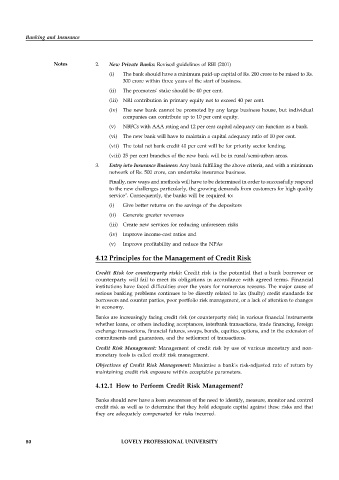Page 85 - DMGT303_BANKING_AND_INSURANCE
P. 85
Banking and Insurance
Notes 2. New Private Banks: Revised guidelines of RBI (2001)
(i) The bank should have a minimum paid-up capital of Rs. 200 crore to be raised to Rs.
300 crore within three years of the start of business.
(ii) The promoters' stake should be 40 per cent.
(iii) NRI contribution in primary equity not to exceed 40 per cent.
(iv) The new bank cannot be promoted by any large business house, but individual
companies can contribute up to 10 per cent equity.
(v) NBFCs with AAA rating and 12 per cent capital adequacy can function as a bank.
(vi) The new bank will have to maintain a capital adequacy ratio of 10 per cent.
(vii) The total net bank credit 40 per cent will be for priority sector lending.
(viii) 25 per cent branches of the new bank will be in rural/semi-urban areas.
3. Entry into Insurance Business: Any bank fulfilling the above criteria, and with a minimum
network of Rs. 500 crore, can undertake insurance business.
Finally, new ways and methods will have to be determined in order to successfully respond
to the new challenges particularly, the growing demands from customers for high quality
service". Consequently, the banks will be required to:
(i) Give better returns on the savings of the depositors
(ii) Generate greater revenues
(iii) Create new services for reducing unforeseen risks
(iv) Improve income-cost ratios and
(v) Improve profitability and reduce the NPAs
4.12 Principles for the Management of Credit Risk
Credit Risk (or counterparty risk): Credit risk is the potential that a bank borrower or
counterparty will fail to meet its obligations in accordance with agreed terms. Financial
institutions have faced difficulties over the years for numerous reasons. The major cause of
serious banking problems continues to be directly related to lax (faulty) credit standards for
borrowers and counter parties, poor portfolio risk management, or a lack of attention to changes
in economy.
Banks are increasingly facing credit risk (or counterparty risk) in various financial instruments
whether loans, or others including acceptances, interbank transactions, trade financing, foreign
exchange transactions, financial futures, swaps, bonds, equities, options, and in the extension of
commitments and guarantees, and the settlement of transactions.
Credit Risk Management: Management of credit risk by use of various monetary and non-
monetary tools is called credit risk management.
Objectives of Credit Risk Management: Maximise a bank's risk-adjusted rate of return by
maintaining credit risk exposure within acceptable parameters.
4.12.1 How to Perform Credit Risk Management?
Banks should now have a keen awareness of the need to identify, measure, monitor and control
credit risk as well as to determine that they hold adequate capital against these risks and that
they are adequately compensated for risks incurred.
80 LOVELY PROFESSIONAL UNIVERSITY

